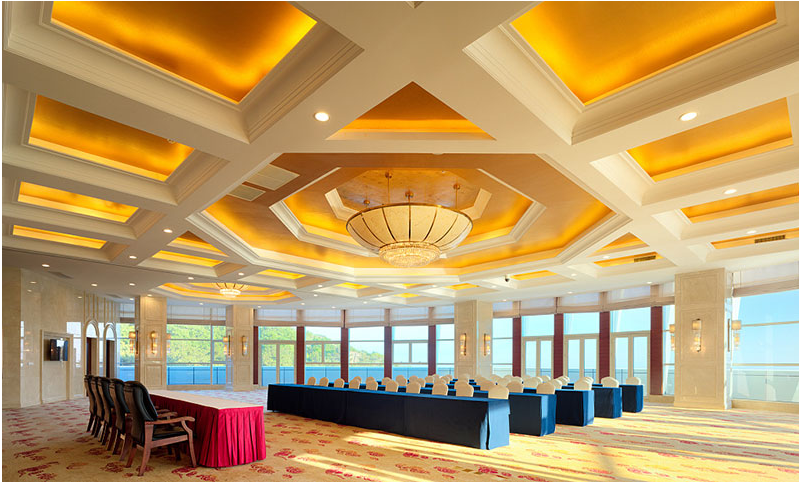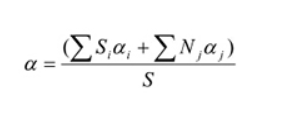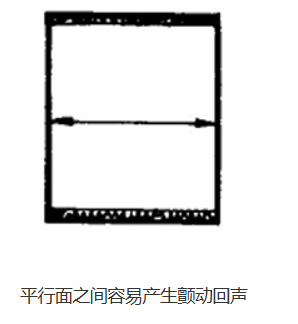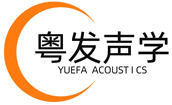notice:
Search:
Multi functional Hall Acoustic Design Scheme

admin
Acoustic PET Felt Panels Factory | Akupanel & Acoustic Wall Panels Manufacturer - Guangdong Yuefa Acoustic New Materials Co., Ltd

1、 Project Overview
This plan takes the multifunctional hall with a building area of about 176.1 square meters, a height of about 3 meters, and an indoor volume of about 530m3 as an example to explain the architectural acoustic design scheme of the multifunctional hall.
The main acoustic requirement in a multifunctional hall is to ensure clear listening of language sounds. This requires strict control of the full frequency reverberation time (especially low-frequency reverberation time) in the multifunctional hall, and controlling low-frequency reverberation time is a difficult task in the acoustic field that cannot be solved by decorative professionals.
Design requirements: In accordance with the national standard "Code for acoustic design of theaters, cinemas, and conference halls" and the proposed acoustic indicators and measures, various parameters are controlled through design calculations, various defects are eliminated, and the internal acoustic environment quality of the space is improved to ensure the normal use of functional rooms. To achieve both aesthetic and practical effects in interior decoration design.
Design objective:
1) Obtain appropriate reverberation time and frequency characteristics for indoor space, and control the intermediate frequency reverberation time within the range of 1.0s under full field conditions to achieve a good sound quality environment and speech clarity.
2) Acoustic defects such as silent standing waves, trembling echoes, and multiple echoes.
2、 Basic parameters of acoustic design
2.1 Reverberation time
The reverberation time T60 refers to the time it takes for the sound source to stop producing sound after the indoor sound field reaches a steady state, and from this moment until the sound pressure level decays by 60dB. It is one of the most important objective indicators for evaluating the sound quality of a room.
The calculation formula for T60 is:

Among them, the average indoor sound absorption coefficient is:

V - Room volume, m3;
S - Total indoor surface area, m2;
α— Indoor average sound absorption coefficient;
M - Sound attenuation coefficient in the air (M-1);
Si - surface area of each indoor part, m2;
α I - the sound absorption coefficient corresponding to Si;
Nj - number of people or objects, m2;
α J - The sound absorption coefficient corresponding to Ni.
The length of reverberation time directly affects the listening effect. Excessive reverberation time can affect the clarity of listening and may cause whistling and hinder the transmission gain of the sound reinforcement system. Being too short can make the sound dry, weak, and unnatural, affecting people's normal ability to distinguish sound. Therefore, it is necessary to arrange sound-absorbing materials reasonably to make the frequency characteristic curve tend to be basically flat, in order to achieve an appropriate reverberation time.
2.2 Background noise (RN)
Environmental noise mainly includes external environmental noise of buildings and internal environmental noise of buildings.
The external environmental noise of buildings includes: transportation noise, factory noise, construction noise, commercial noise, social life noise, etc.
The environmental noise inside the building includes: pedestrian flow noise in equipment rooms such as pump rooms, air conditioning rooms, and elevator rooms, lobby and corridors, as well as floor impact noise generated by upper level personnel activities.
2.3 No sound quality defects such as low-frequency resonance and acoustic staining
Trembling echoes are a series of closely followed reflected pulse sounds caused by the same original pulse sound. It is very easy to produce vibration echo phenomenon between parallel surfaces.
Sound focusing refers to the reflection of sound through a concave surface and focusing it on one point, resulting in uneven distribution of the sound field. Concave curved walls are prone to sound focusing.
To improve the sound listening effect of the conference room, it is not only necessary to control the reverberation time inside the hall, but also to eliminate acoustic defects such as sound focusing and trembling echoes, so as to make the speech in the hall clear and the sound field uniform.

3、 Standard specifications and design basis
3.1 "Building Sound Insulation and Absorption Structures" (National Building Standard Design Atlas 08J931);
3.2 "Code for Fire Protection Design of Interior Decoration of Buildings" (GB50222-95);
3.3 "Code for Indoor Environmental Pollution Control of Civil Building Engineering" GB50325-2001;
3.4 "Quality Standards for Sound Environment" GB3096-2008;
3.5 "Measurement Specification for Hall Reverberation Time" GBJ76-84;
3.6 "Code for acoustic design of theaters, cinemas, and multi-purpose halls" GB/T50356-2005;
3.7 Requirements of Party A and related architectural and decorative drawings
4、 Acoustic Analysis of Places
1. The multifunctional hall has a volume of 528m3, which is prone to producing echoes and multiple echoes, making it difficult for people to hear.
2. 17.5m long, with a large free sound path, it is prone to echo generation.
3. The venue is rectangular and has parallel walls, which are prone to producing vibration echoes between them.
4. The ceiling of the venue is parallel to the roof, and parallel to the floor tiles can easily form multiple reflections. The above phenomena can cause sound defects in the venue, affecting the listening effect of the audience. It is necessary to install acoustic materials reasonably in order to improve and eliminate sound defects.
5、 Acoustic scheme suggestions
metope
The main functional requirements of the multifunctional hall are: primarily for meetings; In order to improve the uniformity of indoor sound field, ensure the clarity of indoor language, eliminate acoustic defects such as indoor echoes, multiple echoes, and trembling echoes, sound-absorbing materials with strong sound absorption will be selected to achieve the goal of controlling short reverberation time.
In order to reasonably control the reverberation time in the multifunctional hall, maintain the current decoration design effect, eliminate inherent sound defects in the building, and improve the uniformity of the conference sound field, various acoustic decoration materials should be comprehensively arranged in the multifunctional hall, and the shape, specifications, installation angle, and installation method of these materials should be strictly controlled.
It is recommended to install a 90mm E-grade sound-absorbing board on the wall, with a height of 3m. The vibration and multiple echoes of parallel walls are eliminated through the sound absorption of the wall.
6、 Design effect
6.1 The decoration is beautiful and generous, with a comfortable and good visual experience.
6.2 The sound-absorbing material is free from dust pollution caused by fiberglass particles and formaldehyde pollution, meeting the environmental requirements for air quality in the premises.
6.3 Have good timbre. Moderate balance of low, medium, and high tones.
6.4 Clear listening in the venue, silent staining and other sound quality defects.
After the implementation of the 6.5 project, the sound environment and on-site environment are suitable, meeting the full reverberation time index and meeting national standards.
7、 Material performance requirements
90mm thick E-grade sound-absorbing board
(1) Finished product - multifunctional hall use.
(2) Structure: Install sound-absorbing cotton embedded in the keel, with wood and stone groove hole board finish.
(3) The thickness of the wooden slot hole board is 15mm, the slot width is 3mm, the slot edge distance is 13mm, and the perforation rate is about 11%.
(4) The 24-hour release of glass fiber particles is 0.01mg/m3, which is better than the national standard limit of 0.15mg/m3.
(5) The requirements for product sound absorption coefficient are as follows:

Explanation: Both environmental performance and sound absorption coefficient require testing reports from national authoritative institutions.
8、 Characteristics of the plan
8.1 Acoustic calculations shall be conducted using years of mature experience and calculation software;
8.2 The noise in the venue has been improved to a certain extent;
8.3 Acoustic materials are aesthetically pleasing and have strong plasticity;
8.4 Free from fiberglass dust and formaldehyde pollution, meeting environmental protection requirements;
8.5 The wall sound-absorbing material has good impact resistance and anti fouling performance.
9、 Explanation
The measures to ensure that the designed sound absorption effect meets the design standards are:
1) This plan is based on specific acoustic materials for simulation, analysis, and calculation. It is necessary to strictly follow the acoustic parameters of the acoustic materials used in the design to achieve the design effect. If a new building acoustic material is replaced, it must be appraised by a building acoustic engineer before use;
2) The construction quality should be strict and accurate. During the construction process, construction must be carried out according to the acoustic material parameters confirmed in the design. If there are any changes, they should be notified to the acoustic engineer and calculated and confirmed before replacement.

Hot products
-
Premium Decorative Natural Grooved Akupanel Wooden Acoustic Panels – Direct from China Manufacturer
As a leading China-based acoustic panel factory, we specialize in crafting high-quality Decorative Natural Grooved Akupanel Wooden Acoustic Wall Panels that combine aesthetic appeal with superior sound absorption. Our products are engineered for architects, interior designers, and contractors seeking eco-friendly acoustic solutions with customizable designs.
-
Micro Perforated Wood Acoustic Panel
The materials of Micro Perforated Wood Acoustic Panels are made of MDF with microperforations on the visible side and big holes in the back side.
-
300x300mm Hexagon Wall Panels - Soundproof Polyester Fiber Acoustic Panels for Easy Installation
Upgrade your space with our 300x300mm hexagon acoustic panels. Made from high-density polyester fiber, these soundproof wall panels effectively reduce noise and echo. Quick installation, stylish design, and premium sound absorption for offices, studios, and homes.
-
24mm PET Acoustic Panels Polyester Fiber Sound Absorbing Material
Our 24mm PET Acoustic Panel answers your acoustical and aesthetic needs with its strong sound-absorbing performance, durability, and elegant appearance. These panels are used for sound reduction and reverberation control. Available in a wide variety of sizes, thicknesses, fabric styles, and colors. 24mm PET Acoustic Panels allow you to create an effective sound control treatment that is distinctly appropriate for your environment.
-
Perforated Wood Acoustic Panel
Product introduction: Acoustic Wood panels is a sound-absorbing material of MDF material with many holes. It is widely used in theater, restaurant, household and other places which need to reduce noise. DIY Perforated Acoustic Panel Precautions: l Wood or melamine veneer with different colors is natural phenomenon. l Pay attention to moisture before installation. Please keep them in a dry environment.
-
Sound Insulation Wood Wool Acoustic Panel
Wood fiber acoustic board is a decoration and sound insulation material, using pure wood wool as raw material which is characterized by available for a variety of colors and patterns to choose from, the finishes color can be adjusted according to the requirements of the acoustic renovation or investors; wool wood acoustic panel sound absorption spectrum is high, which have fairly good results for low, medium and high frequency noises, and good fire-proof, no dust pollution, strong decorative and simple to use. There are many specification levels available for investors to choose, you can simply note when ordering.
-
20mm polyster fiber panel directly supplied by Chinese manufacturers
PET Acoustic Panel is made from 100% polyester,by needle punching processing. The production processis completely physical&eco-friendly, no waste water,emissions, waste. no adhesive, The porous nature ofacoustic panel makes it sound absorptive&thermalinsulative.
-
Wholesale Anti-Vibration Pads
Source high-quality wholesale anti-vibration pads for machinery, construction, and OEM projects. Get competitive bulk pricing, global shipping, and custom solutions from trusted suppliers.
-
Wooden Grooved Wall Panels
China's Leading Wooden Grooved Wall Panels Manufacturer - Get premium quality acoustic wood slat panels at factory-direct prices. Our FSC-certified grooved wall panels feature custom CNC designs (5-20mm depth), excellent sound absorption (NRC 0.6-0.9), and 12+ finish options. Ideal for commercial spaces, residential interiors, and acoustic treatment. ISO 9001 certified with 15+ years experience. MOQ 100㎡ with free samples available. OEM/ODM services supported. Contact us today for wholesale pricing from China's trusted wood wall panel supplier!
-
Modern Office Meeting Pods - 2 Steel Walls + 2 Glass Walls - Custom Sizes Available
China factory-direct manufacturer of premium soundproof meeting pods featuring 2 metal walls + 2 glass walls. Our ISO-certified office pods deliver 38dB noise reduction with quick-ship modular designs. Custom sizes/colors available with 5-year warranty. Ideal for offices, coworking spaces & universities. Competitive pricing with bulk order discounts. Request CAD files & quotes today!
-
Wall And Ceiling Acoustic Perforated Wood Panels
Premium grade perforated wood acoustic panels for wall and ceiling applications. Achieve 0.90 NRC with Class A fire-rated natural wood panels. Custom patterns & finishes for architectural acoustics.
-
Standard 9 mm PET Felt panels
Discover customizable acoustic wall panels made from 100% recycled PET polyester fiber. Achieve NRC 0.85+ sound absorption with eco-safe (12 bottles recycled/panel), fire-resistant (Class A/B1) solutions. Perfect for studios, offices & modern interiors. Custom sizes/colors available. LEED & GREENGUARD Gold certified.
-
Polyester Acoustic Panel (standard)
High-performance polyester fiber acoustic panels for noise control and sound absorption. Eco-friendly soundproofing solution for commercial and residential spaces with Class A fire rating.
-
Private Soundproof Pod Booth For Office
Flexible and movable soundproof booth.the interior is equipped with polyester fiber sound-absorbing panels. It has the advantages of fire prevention, safety and stability.
-
Smoked oak sound-absorbing board, black felt
As a leading Chinese acoustic panel manufacturer, our factory specializes in producing Akupanel wooden slat acoustic panels that combine aesthetic appeal with superior noise reduction performance. These wood wall acoustic panels are ISO 9001 certified, featuring Class A fire ratings and NRC 0.85 sound absorption coefficients.
-
Waterproof PVC Sound Barriers
Our sound insulation products help protect and reduce the impact of industrial noise on surrounding residents and on-site workers.We use the world's leading acoustic technology and innovative material design to provide the most effective temporary sound solutions on the market.The one of most important thing is that soundproof products can work under various conditions on any construction site.
Cases
-
Acoustic architectural decoration of the multifunctional hall at Xinyu Ninth Middle School
Yuefa Acoustics provides professional multifunctional hall acoustic decoration design solutions, including architectural acoustics, sound reinforcement, and noise control design, with the aim of ensuring language clarity in the audience seats.
-
Acoustic Renovation Case of Lecture Hall (Dongguan Songshan Lake School Junior High School Project) - Yuefa Acoustics
The lecture hall is not only used for hosting large-scale conferences, cultural performances, and social events, but also often serves multiple functions such as education and training, exhibitions, etc. The goal of acoustic renovation is to optimize the sound field distribution, reduce noise interference, and improve audio clarity, so that the auditorium can better adapt to various needs.
-
Songshan Lake Taiwan Garden North School - Classroom Acoustic Decoration Project
In the current educational environment, the acoustic design and decoration of classrooms are receiving increasing attention. A good acoustic environment can not only improve students' learning efficiency, but also provide teachers with a better teaching space. As a modern educational institution, Songshan Lake Taiwan Garden North School has realized this and therefore carried out classroom acoustic decoration projects in order to create an ideal learning and teaching environment for teachers and students.
-
Acoustic Decoration Project of Guangzhou Metro Museum
Acoustic Decoration Project of Guangzhou Metro Museum
-
Acoustic Decoration Project for Lecture Hall - Nanhai Middle School Renovation and Expansion Project
The original acoustic design of the auditorium at Nanhai Middle School can no longer meet the needs of modern teaching and activities, especially in large-scale lectures, conferences, and cultural events. The uniformity of the sound field and the clarity of speech directly affect the efficiency of information transmission and learning outcomes. Therefore, carrying out scientific and reasonable acoustic decoration is the top priority of current work.
-
Shenzhen Longhua Experimental School Concert Hall
Shenzhen Longhua Experimental School Concert Hall
-
Nanhai Middle School Lecture Hall
The original acoustic design of the auditorium at Nanhai Middle School can no longer meet the needs of modern teaching and activities, especially in large-scale lectures, conferences, and cultural events. The uniformity of the sound field and the clarity of speech directly affect the efficiency of information transmission and learning outcomes. Therefore, carrying out scientific and reasonable acoustic decoration is the top priority of current work.
Online Service



